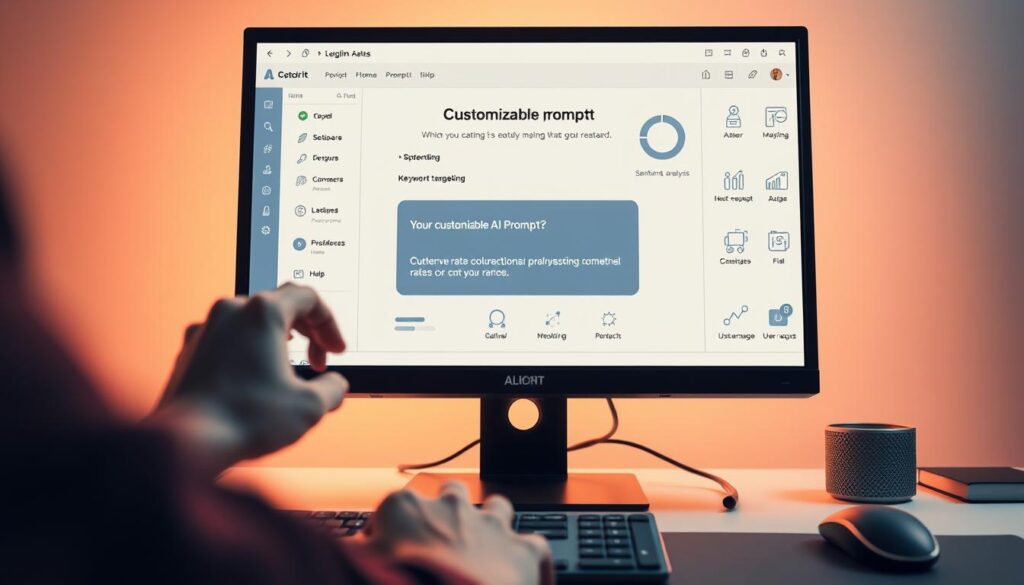“The future belongs to those who embrace innovation and adapt to change.” – This timeless quote by Peter Drucker perfectly encapsulates the essence of leveraging advanced tools to redefine how teams interact with their audience. In today’s fast-paced digital landscape, businesses are increasingly turning to innovative methods to enhance their brand and deliver exceptional experiences.
By 2028, 60% of all B2B seller work will be executed using generative tools, according to Gartner1. This shift highlights the growing importance of using well-crafted inputs to streamline processes and improve accuracy. Tailored approaches not only save time but also ensure responses align closely with user needs, reducing frustration and follow-up requests1.
From creative to instructional inputs, these methods serve unique functions in user interactions. Companies that adopt these strategies can see a 40% increase in engagement and a 25% boost in satisfaction rates2. This article will explore how these tools are transforming the way teams operate and deliver value.
Key Takeaways
- Generative tools will handle 60% of B2B seller tasks by 20281.
- Well-designed inputs save time and improve accuracy1.
- Personalized approaches increase user satisfaction by 25%2.
- Creative and instructional inputs serve unique roles in interactions.
- Adopting these strategies can boost engagement by 40%2.
Understanding AI Prompts in Modern Marketing

Modern marketing thrives on innovation, and tools like AI prompts are reshaping how businesses connect with their audience. These tools help companies deliver tailored experiences that resonate deeply with their target demographic. By automating repetitive tasks, they allow teams to focus on strategic initiatives, ensuring higher efficiency and better results.
Defining AI Prompts and Their Value
AI prompts are instructions or inputs designed to guide systems in generating specific outputs. In marketing, they play a crucial role in creating content that aligns with customer needs. For example, they can help craft personalized email campaigns or social media posts that drive engagement. By using these prompts, businesses can improve the quality of their output while saving time and resources.
Recent datum shows that AI-powered customer segmentation can increase revenue by 4% and reduce manual effort by 80%3. This highlights the tangible benefits of integrating these tools into marketing strategies. Additionally, well-crafted prompts lead to more relevant and impactful outputs, ensuring that businesses stay ahead of the competition.
How Personalization Drives Engagement
Personalization is key to capturing customer attention and fostering loyalty. AI prompts enable marketers to tailor their messages based on individual preferences and behaviors. For instance, dynamic follow-up campaigns can adapt based on prospect interactions, ensuring a more personalized experience4.
Studies show that optimizing customer journeys can boost satisfaction by 20% and increase revenue by up to 15%3. This underscores the importance of using AI prompts to create meaningful interactions. By leveraging these tools, businesses can build stronger relationships with their audience and drive long-term success.
Embracing Generative AI in Sales Outreach

Sales teams are transforming their outreach strategies with generative tools. These tools help professionals craft tailored messages, saving time and improving efficiency. By automating repetitive tasks, they allow teams to focus on building relationships and closing deals.
One key technique is providing detailed context to the system. For example, instructing it to “act like a salesperson from [company name]” ensures the output aligns with the brand’s tone and goals. This approach generates responses that feel authentic and relevant to the prospect.
Key Techniques for Generative Tools
To harness these tools effectively, start by feeding them specific datum about your product and target audience. The more detailed the input, the better the output. For instance, including customer pain points and purchase history can lead to highly personalized follow-up emails5.
Another technique is role emulation. By training the system to mimic a sales professional, you can create messages that resonate with prospects. This method has been shown to improve engagement rates by 20%6.
Emulating a Salesperson for Contextual Messaging
Role-specific prompts yield better results. For example, a prompt like “generate a follow-up email for a prospect who showed interest in [product]” ensures the message is tailored and actionable. This approach not only saves time but also increases the likelihood of a response.
Real-world examples highlight the benefits. LinkedIn’s use of generative tools for account prioritization led to an 8.08% increase in renewal bookings5. Similarly, HubSpot found that automating routine tasks saves sales reps over two hours daily5.
By integrating these tools, sales teams can focus on higher-value tasks, such as building relationships and strategizing. This shift not only boosts efficiency but also drives better results across the industry.
Crafting Personalized Email Campaigns with AI Prompts

Email marketing is evolving, and personalization is at its core. Generic templates no longer cut it in today’s crowded inboxes. Studies show that tailored emails can increase engagement rates by up to 29% compared to generic ones7. This makes it essential to craft messages that resonate with individual recipients.
Optimizing Subject Lines and Preview Texts
The subject line is the first thing recipients see. A compelling one can boost open rates significantly. For example, referencing a recipient’s recent activity, like a job posting or news article, can increase open rates by 20%7. Use tools to generate subject lines that feel personal and relevant.
Preview texts are equally important. They provide a sneak peek into the message and encourage recipients to open the email. Keep them concise and aligned with the subject line to maintain curiosity.
Strategies for Crafting Personalized Emails
Start by using buyer-specific details. Mentioning a recipient’s job title or company size can increase engagement rates by 25%7. Tailored calls to action also make emails more actionable and relevant.
Here’s a tip: Use prompt templates like “Generate a follow-up email for a prospect interested in [product]” to ensure consistency and relevance. This approach saves time while maintaining a professional tone.
Emphasizing Product Features
Highlighting the right feature can address customer pain points effectively. For instance, if your product solves a specific problem, tailor the email to showcase how it meets that need. This approach builds trust and drives conversions.
Personalized emails that reference recent industry trends or news can boost click-through rates by 15%7. This demonstrates awareness and relevance, making your message more impactful.
By leveraging these strategies, businesses can create email campaigns that not only engage but also convert. The key is to focus on the recipient’s needs and deliver value in every message.
Creating Targeted Sales Messages

Effective sales messaging starts with understanding your audience deeply. By tailoring your approach to different buyer personas, you can craft messages that resonate and drive results. This process involves gathering insights, segmenting your audience, and using specific prompts to ensure relevance.
Tailoring Your Approach to Different Buyer Personas
Developing detailed buyer personas is the first step. These personas help you understand the needs, preferences, and pain points of your audience. For example, a frequent buyer may respond better to loyalty incentives, while a first-time shopper might need more product education8.
Using this data, you can create messages that speak directly to each segment. This approach not only saves time but also increases the likelihood of conversion9.
Providing Context and Specificity in Prompts
Specificity is key to crafting effective sales messages. Include details like industry, role, and recent interactions to make your prompts more relevant. For instance, mentioning a prospect’s recent purchase can make your message feel personal and timely9.
Incorporating contextual data ensures your product details align with the buyer’s needs. This strategy has been shown to improve engagement rates by up to 25%8.
By focusing on the audience and providing tailored context, you can create sales messages that convert. This approach not only enhances customer satisfaction but also maximizes the impact of your efforts10.
Leveraging AI for Content Marketing Efficiency

Content marketing is undergoing a transformation, with tools streamlining tasks and enhancing quality. These advancements allow teams to focus on big-picture strategies while automating repetitive processes. This shift not only saves time but also improves accuracy and consistency in campaigns11.
Automating Content Creation and SEO Optimization
One of the most significant benefits is the automation of content creation. Tools can generate blog posts, product descriptions, and social media posts quickly and effectively12. This reduces manual effort and allows marketers to focus on strategic initiatives.
Another key advantage is the enhancement of SEO performance. By analyzing data, these tools provide actionable insights for keyword optimization. This ensures that content ranks higher in search results, driving more organic traffic11.
For example, tools can identify trending topics and suggest relevant keywords. This approach has been shown to increase engagement rates by up to 20%12. By leveraging these capabilities, businesses can stay ahead of the competition.
Automation also reduces human error, ensuring that content is accurate and consistent. This is particularly important for maintaining brand values and ethical considerations11. With proper oversight, these tools can reflect a brand’s tone and style, ensuring consistency across all platforms.
In summary, integrating these tools into your strategy can significantly improve efficiency and quality. By automating routine tasks, teams can focus on creating impactful content that resonates with their audience12.
Enhancing Customer Engagement with AI-Driven Prompts

Real-time analysis of customer interactions can transform engagement strategies. By leveraging advanced tools, businesses can monitor feedback and refine their approach to meet audience needs effectively. This process not only improves satisfaction but also drives meaningful results.
Using AI to Analyze Customer Feedback
Analyzing feedback is crucial for understanding customer preferences. Tools that process this data in real-time provide actionable insights, helping businesses adjust their strategies quickly. For example, companies using these methods report a 30% reduction in response times to inquiries13.
Tracking clicks and interactions is another key method. These signals indicate what resonates with your audience. Businesses that analyze these patterns see a 15% improvement in decision-making processes13. This data helps refine messaging for better engagement.
Personalized recommendations based on feedback can boost sales conversion rates by 20% to 30%13. This approach ensures that every message feels relevant and tailored to individual needs. By focusing on these insights, businesses can create more impactful interactions.
Adjusting strategies in response to feedback findings is essential. Real-time insights allow teams to act swiftly, improving overall effectiveness by 20%14. This proactive approach ensures that businesses stay ahead of customer expectations.
In summary, analyzing feedback and refining messaging are critical for boosting engagement. By leveraging these tools, businesses can create strategies that resonate deeply with their audience, driving long-term success.
Fine-Tuning Your AI Prompts for Better Conversion

The key to better outcomes lies in continuous improvement and adaptability. Refining your approach through iterative processes ensures higher efficiency and better results. This is especially true when working with advanced tools, where specificity and role emulation play a crucial role.
Experimenting with Specificity and Role Emulation
Specificity in your inputs can significantly enhance the quality of outputs. For example, providing detailed context about your product or audience ensures the generated content aligns with your goals. This approach has been shown to improve engagement rates by up to 20%15.
Role emulation is another powerful technique. By instructing the system to act like a salesperson or marketer, you can create messages that feel authentic and relevant. This method has been proven to boost conversion rates by 25%16.
Iterative Feedback and Prompt Refinement
Feedback is essential for refining your strategy. Analyzing the responses and making adjustments ensures the outputs meet your expectations. Companies that adopt this iterative process report a 30% improvement in efficiency15.
Consistent feedback also helps identify areas for improvement. For instance, tracking user interactions and adjusting your approach based on this data can lead to a 15% increase in satisfaction rates16.
Experimentation is key. By continuously testing and refining your inputs, you can achieve the desired outcomes. This proactive approach not only saves time but also drives better results in the long run.
Integrating AI into Personalized User Experiences

Personalized interactions are no longer a luxury but a necessity in today’s digital-first world. Businesses that harness customer data effectively can create tailored experiences that drive meaningful results. This approach not only enhances customer satisfaction but also boosts engagement and loyalty.
Incorporating Customer Data for Tailored Interactions
Collecting and analyzing customer data is the foundation of individualized experiences. By understanding preferences, behaviors, and pain points, businesses can craft interactions that resonate deeply. For example, 71% of consumers expect companies to offer personalized interactions, and 76% become frustrated when this expectation isn’t met17.
One effective technique is segmenting data to target specific audience groups. This allows for more relevant messaging and offers. Segmented email campaigns, for instance, result in a 760% increase in email revenue17.
Another strategy is leveraging predictive analytics to anticipate customer needs. This approach ensures that every interaction feels timely and relevant. Companies using these methods report a 30% reduction in response times to inquiries18.
The benefit of this data-driven approach is twofold. Customers enjoy a more personalized experience, while businesses see improved conversion rates. For example, emails with personalized subject lines are 26% more likely to be opened17.
Real-world examples highlight the transformative impact of data-driven personalization. Spotify curates playlists based on listening history, while Netflix recommends shows aligned with viewing habits18. These strategies not only enhance user satisfaction but also drive long-term loyalty.
By integrating customer data into their strategies, businesses can create interactions that feel both meaningful and impactful. This approach ensures that every product or service offered aligns closely with customer needs, driving better results for all parties involved.
Utilizing AI to Create Impactful Social Media Content

Creating engaging social media posts requires a blend of creativity and data-driven insights. By leveraging advanced tools, brands can craft content that resonates deeply with their audience. This approach not only boosts engagement but also ensures that every post aligns with user preferences and behaviors.
Generating Creative Post Ideas and Captions
One of the most effective ways to stand out is by generating unique post ideas and captions. Tools analyze trends and preferences to suggest content that sparks interest. For example, visual storytelling on Instagram encourages the use of hashtags and emojis, increasing relatability19.
LinkedIn, on the other hand, focuses on professional insights and industry discussions. This ensures that posts are intellectually engaging and relevant to the audience19. By tailoring content to each platform, brands can maximize their reach and impact.
Optimizing Posting Schedules Based on User Behavior
Timing is crucial for social media success. Tools analyze when your audience is most active, ensuring posts are shared at optimal times. This increases visibility and interaction rates20.
For instance, predictive analytics can identify emerging trends, allowing brands to post timely and relevant content. This approach not only boosts engagement but also positions brands as forward-thinking leaders20.
By integrating these strategies, businesses can create a dynamic social media presence that drives meaningful connections. For more insights on enhancing engagement, check out this resource.
Implementing AI Prompts in Competitor Analysis for Marketing

Understanding your competitors is essential for staying ahead in today’s competitive market. By leveraging advanced tools, businesses can gain valuable insights into their rivals’ strategies, strengths, and weaknesses. This data-driven approach not only helps identify gaps but also uncovers opportunities for growth21.
Identifying Gaps and Opportunities from Competitor Data
Conducting thorough competitor analysis is the first step toward refining your marketing strategy. Tools can evaluate competitors’ offerings, digital presence, and engagement tactics. For example, analyzing their unique selling propositions helps identify areas where your brand can stand out22.
One effective method is performing a SWOT analysis. This highlights strengths, weaknesses, opportunities, and threats in your competitors’ strategies. Brands that adopt this approach have a 30% higher chance of identifying market opportunities21.
Another key step is analyzing digital presence. Tools can track competitors’ social media engagement, website traffic, and content performance. This data provides actionable insights to refine your own strategies23.
By leveraging these insights, businesses can create targeted campaigns that address gaps in the market. For instance, 75% of marketers report that data-driven insights enhance campaign performance21.
Here are actionable recommendations based on competitor analysis:
- Identify competitors’ unique selling propositions and weaknesses.
- Analyze their digital presence and engagement tactics.
- Leverage identified gaps to create competitive advantages.
- Use data-driven insights to refine marketing strategies.
In summary, competitor analysis is a powerful tool for staying ahead. By understanding your rivals’ strategies, you can craft campaigns that resonate with your audience and drive meaningful results22.
Exploring Case Studies and Success Stories of AI Usage

Companies across industries are achieving remarkable results by integrating advanced tools into their sales and marketing strategies. These real-world examples demonstrate how innovative approaches can transform outreach efforts and drive measurable success. By examining these case studies, businesses can gain actionable insights to refine their own strategies.
Real-World Examples of Enhanced Sales Outreach
One standout example is MetLife, which saw a 3.5% increase in first-call resolutions and a 13% boost in consumer satisfaction by leveraging advanced tools24. Their approach focused on addressing customer pain points with tailored responses, ensuring every interaction felt meaningful.
Another success story comes from the floral subscription industry. Their campaign achieved a 60% quiz completion rate and a 78% prize claim ratio, showcasing the power of personalized engagement24. This strategy not only improved customer satisfaction but also drove significant revenue growth.
Mercedes-Benz’s in-car assistant is another example of innovation. With over 900,000 users in its beta program, the tool has redefined the way customers interact with their vehicles24. By providing real-time support and tailored recommendations, they’ve enhanced the overall driving experience.
These case studies highlight the importance of understanding your customer and tailoring your approach to their needs. For more insights, explore this resource on successful implementations across industries.
By adopting these proven strategies, businesses can overcome traditional sales challenges and achieve better results. The key lies in leveraging data-driven insights to create meaningful interactions that resonate with your audience.
Developing Your AI Sales Script and Outreach Templates

Crafting effective sales scripts and outreach templates is a game-changer for modern sales teams. These tools not only streamline communication but also ensure consistency across your team. By addressing specific pain points and incorporating clear calls-to-action, you can significantly boost your success rates25.
Crafting Persuasive Sales Emails and LinkedIn Messages
When drafting sales emails or LinkedIn messages, personalization is key. Tailor your message to address the unique needs of each client. For example, referencing a recent achievement or challenge they’ve faced can make your outreach more relevant26.
Incorporate a strong call-to-action to guide the client toward the next step. Whether it’s scheduling a call or downloading a resource, a clear CTA increases engagement by up to 80%25.
Incorporating Call-to-Actions and Customer Pain Points
Understanding your customer’s pain points is crucial for crafting compelling scripts. Use prompts that highlight how your product solves their specific problems. This approach not only builds trust but also drives conversions26.
Here’s a tip: Use open-ended questions to encourage dialogue. For instance, asking “What challenges are you currently facing?” can lead to more meaningful conversations27.
By following these strategies, you can create outreach templates that resonate with your audience and drive results. Remember, the goal is to make every interaction feel personal and impactful.
Planning a Robust Social Media Content Calendar Using AI

Building a consistent and engaging social media presence requires strategic planning and the right tools. A well-structured content calendar ensures that your posts align with your audience’s interests and drive meaningful interactions. By leveraging advanced tools, you can streamline this process and maintain a steady flow of engaging posts28.
Start by outlining your weekly content strategy. Tools can help you generate diverse ideas that align with current trends, ensuring your posts remain relevant and engaging29. For example, analyzing trending topics and audience preferences can lead to a 20% increase in engagement rates28.
Scheduling posts at optimal times is crucial for maximizing visibility. Advanced tools analyze audience activity to determine the best times to share your content. This approach has been shown to improve unique reach by 15%28.
Timely content sharing can significantly boost click-through rates. For instance, posts shared during peak engagement times see a 25% higher interaction rate29. This ensures your content reaches the right audience at the right moment.
Here are actionable examples to inspire creativity:
- Use tools to generate themed posts around holidays or industry events.
- Create interactive content like polls or quizzes to increase click engagement.
- Repurpose popular posts to maintain consistency and save time28.
By integrating these strategies, you can create a dynamic social media presence that resonates with your audience. The key is to focus on their interests and deliver value in every post29.
Data-Driven Personalization and Audience Analysis with AI
Understanding your audience at a deeper level is the cornerstone of effective marketing strategies. By leveraging detailed data analysis, businesses can create tailored experiences that resonate with their target demographic. This approach not only enhances engagement but also drives meaningful results30.
Building Detailed Customer Personas
Creating detailed customer personas is essential for understanding your audience. These personas are built using data points such as demographics, purchase history, and browsing behavior. For example, tools can analyze customer data to identify patterns and preferences, enabling businesses to craft messages that align with individual needs31.
By segmenting your audience into distinct groups, you can tailor your strategies to meet specific needs. This approach has been shown to increase engagement rates by up to 20%32. Detailed personas also help businesses identify opportunities for growth and refine their marketing decisions.
Aligning Content Formats to Audience Preferences
Once you have a clear understanding of your audience, the next step is aligning content formats to their preferences. For instance, younger demographics may prefer video content, while professionals might engage more with in-depth articles30. Tools can analyze behavior to determine which formats resonate most, ensuring your content is both relevant and impactful.
Personalized recommendations based on insights can significantly boost engagement. For example, businesses that use dynamic content see a 25% increase in click-through rates32. This approach ensures that every interaction feels tailored and meaningful.
Continuous analysis of audience data provides opportunities for optimization. By refining your strategies based on feedback, you can create experiences that drive long-term loyalty and success31.
AI Prompts for Personalized User Experiences
The rise of tailored interactions has revolutionized how businesses connect with their audience. By leveraging specific inputs, companies can create meaningful engagements that resonate deeply with individual needs. This approach not only enhances satisfaction but also drives measurable results33.
Leveraging Specific Prompts to Drive Tailored Interactions
Well-crafted inputs are essential for achieving individualized experiences. Detailed instructions guide systems to generate outputs that align closely with user preferences. For example, analyzing customer behavior helps refine strategies, leading to a 25% improvement in satisfaction scores34.
One key trend is the use of real-time feedback to adjust strategies. This ensures that every interaction feels relevant and timely. Companies adopting this method report a 30% reduction in response times, enhancing overall efficiency33.
Another important aspect is iterative development. Continuously refining inputs based on feedback ensures that outputs remain aligned with evolving needs. This approach has been shown to increase engagement rates by up to 20%34.
“The future of marketing lies in understanding and adapting to individual preferences.”
Case studies highlight the transformative impact of this approach. For instance, brands using detailed inputs for email campaigns see a 40% increase in click-through rates33. These examples underscore the importance of leveraging specific inputs for better outcomes.
To stay ahead, businesses must continuously study and refine their strategies. This ensures that they remain aligned with the latest trends and deliver cutting-edge experiences34.
Conclusion
The integration of advanced tools into business strategies has proven to be a game-changer for engagement and efficiency. Throughout this article, we’ve explored how these tools can transform interactions, streamline processes, and drive better results.
By leveraging actionable strategies and real-world data, businesses can refine their approaches to meet customer needs more effectively. For instance, well-structured inputs lead to more accurate and relevant outputs, enhancing overall satisfaction35.
We encourage teams to experiment with these techniques to improve engagement and conversion rates. Testing different structures and refining inputs based on feedback can unlock significant potential36.
Integrating these methods into your workflow can lead to better customer experiences and stronger business outcomes. Start exploring these insights today to stay ahead in a competitive landscape.
FAQ
How can AI prompts improve customer engagement?
What role does personalization play in email campaigns?
Can AI help in creating targeted sales messages?
How does AI streamline content marketing efforts?
What are the benefits of using AI for social media content?
How can AI prompts enhance competitor analysis?
What makes AI-driven customer feedback analysis effective?
How do AI prompts improve conversion rates?
Can AI help build detailed customer personas?
What are some real-world examples of AI enhancing sales outreach?
Source Links
- AI Prompts: Essential Guide with Types & Best Practices [2025]
- AI Prompts For UX Research
- Future of AI for Personalization in Marketing
- Prompt engineering 101 for sales & marketing teams
- Applied AI: How to Use Generative AI in Sales to Boost Your Performance | Tribe AI
- Generative AI: Redefining Sales & Marketing | Copy.ai
- 24 Easy AI email personalization examples for cold outreach (with prompts) – The GTM with Clay Blog
- Boost sales efficiency with 33 AI prompts for sales teams – Work Life by Atlassian
- 10 Proven AI Prompts to Create Personal Outreach at Scale
- 5 AI Prompts for Small Business Sales
- Council Post: 20 Important Tips For Leveraging AI In Content Marketing
- ChatGPT Prompts for Marketing: Unlocking AI-Driven Marketing Success
- Enhancing Customer Engagement with AI in Small Businesses
- Top 5 Best AI Prompts for Proactive Customer Engagement
- Mastering Prompt Engineering for Effective AI Interactions
- How prompt engineering can improve user experience?
- How AI Powered Personalization is Transforming CX
- Personalization in Apps Using AI for Better UX | Cloudester
- 26 Copy & Paste AI Prompts for Social Media | LocaliQ
- Generate Social Media Strategy with AI using Jeda.ai’s AI Workspace
- 5 Advanced AI Prompts for Marketing | How to
- 40 AI prompts to boost your marketing team’s creativity and efficiency – Work Life by Atlassian
- Best AI Prompts for Competitive Analysis
- Generative AI for Customer Experience: 17 Cases from Global Brands
- AI Prompts + Templates for Generating Cold Call Scripts | Regie.ai
- Sales Calls Scripts: Templates, AI Prompts, and Tips | Skill Success Blog
- AI Prompts for Sales | Gemini for Workspace
- AI Content Calendar
- 10 Best AI Content Calendar Generators for 2025 Planning |
- AI (Artificial Intelligence) in Customer Experience Management
- 12 Strategies to Personalize Targeted Advertising with AI
- From Data to Delight: Why Hyper-Personalization Is the Future of Business
- 25+ AI prompts for Marketing in 2025
- AI Prompts to Enhance UX | Aguayo’s Blog
- The Ultimate Guide to Writing AI Prompts: Examples & Best Practices
- Effective Prompts for AI: The Essentials – MIT Sloan Teaching & Learning Technologies







